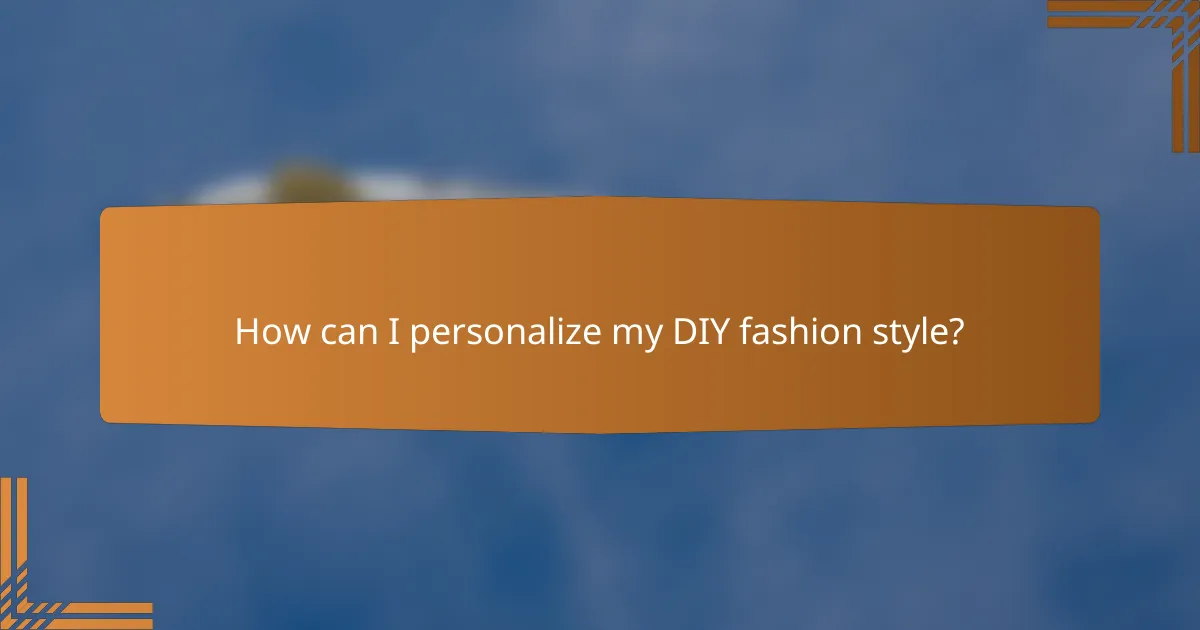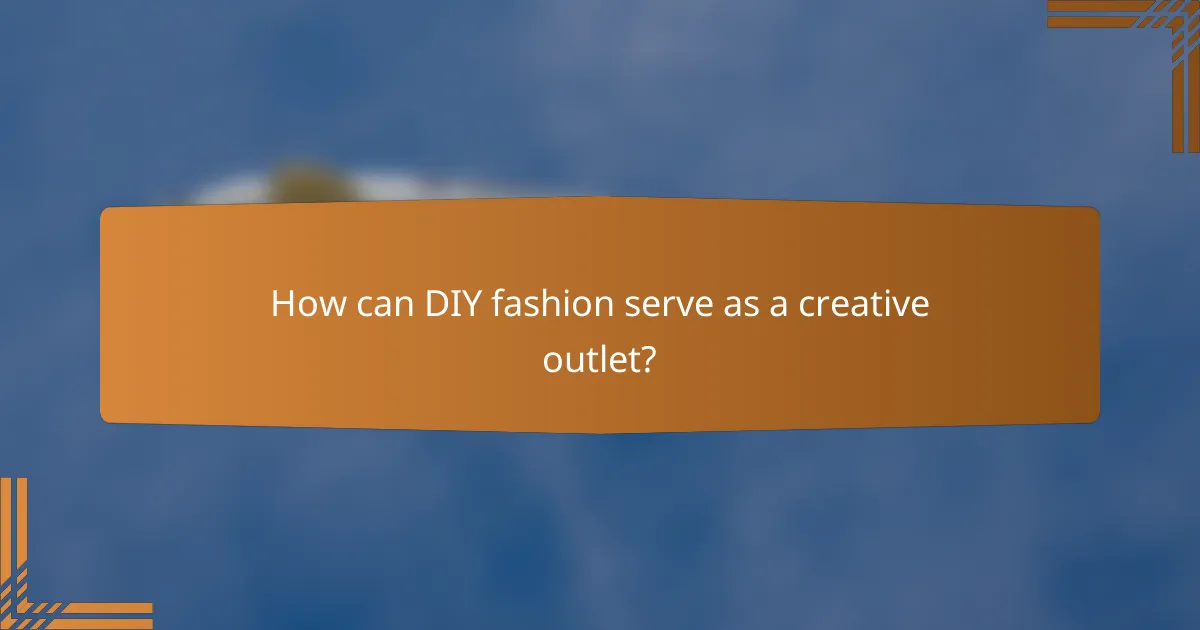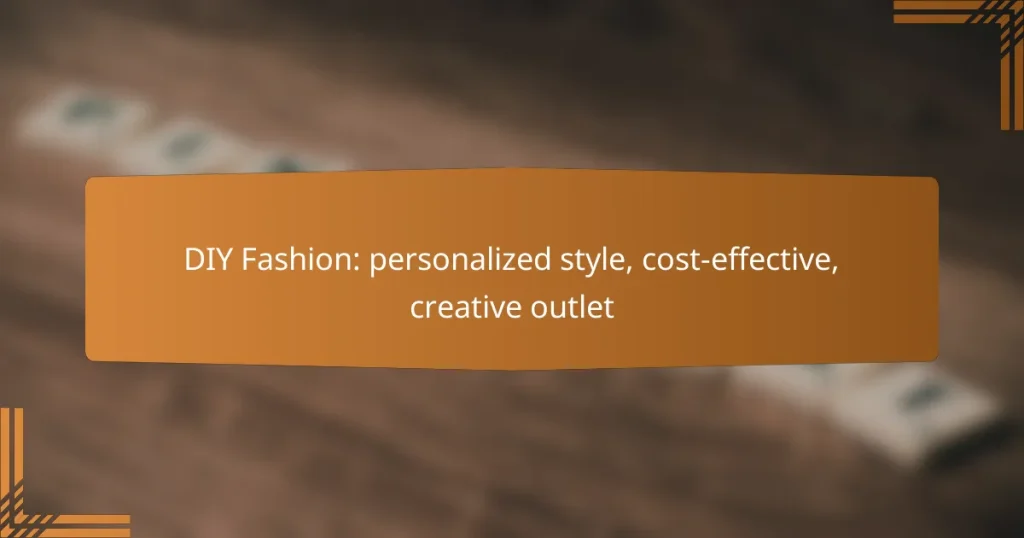DIY fashion offers a unique opportunity to express your personal style while being cost-effective and creative. By modifying existing clothing, utilizing thrifted items, and exploring various crafting techniques, you can create one-of-a-kind pieces that truly reflect who you are. Engaging in this creative outlet not only saves money but also allows you to explore your artistic abilities and connect with a community of like-minded individuals.

How can I personalize my DIY fashion style?
Personalizing your DIY fashion style involves creatively modifying existing clothing to reflect your unique taste. This can include customizing thrifted items, using fabric paint, and incorporating vintage accessories.
Customizing thrifted clothing
Thrifted clothing offers a cost-effective way to develop your personal style. Look for pieces that resonate with you, whether it’s a vintage jacket or a pair of jeans. Consider altering the fit, adding embellishments, or even dyeing the fabric to make it truly yours.
When customizing thrifted items, be mindful of the fabric type and condition. Natural fibers like cotton and wool are easier to work with than synthetics. Always check for any damages that may require repair before starting your project.
Using fabric paint for unique designs
Fabric paint allows you to create one-of-a-kind designs on your clothing. You can use stencils, freehand techniques, or even stamps to apply your artwork. Choose colors that complement your existing wardrobe for a cohesive look.
Before painting, wash and dry the fabric to remove any finishes that may hinder paint adhesion. Test your design on a scrap piece of fabric to ensure the colors and techniques work as intended.
Incorporating vintage accessories
Vintage accessories can elevate any outfit and add a personal touch. Look for items like brooches, scarves, or statement belts at thrift stores or flea markets. These pieces often tell a story and can serve as conversation starters.
When incorporating vintage accessories, aim for balance. If your outfit is bold, opt for subtle accessories, and vice versa. Mixing modern and vintage styles can create a unique aesthetic that showcases your personality.
Upcycling old garments
Upcycling involves transforming old garments into new, stylish pieces. This could mean turning an oversized shirt into a fitted crop top or repurposing a dress into a skirt. The goal is to breathe new life into items that might otherwise go to waste.
Consider the potential of each garment before starting. Look for elements that can be easily altered, such as hems or sleeves. Upcycling not only saves money but also promotes sustainability in fashion.
Creating bespoke patterns
Creating bespoke patterns allows you to design clothing that fits your style perfectly. Start by sketching your ideas or using pattern-making software to visualize your designs. You can draft patterns from scratch or modify existing ones to suit your needs.
When making patterns, pay attention to measurements and fabric drape. Use muslin for test garments to ensure the fit is right before cutting into your final fabric. This process can be time-consuming but results in clothing that is uniquely tailored to you.

What are the cost-effective methods for DIY fashion?
Cost-effective methods for DIY fashion include shopping at charity shops, using discount fabric stores, repurposing household items, and joining DIY fashion communities. These approaches allow you to create personalized styles without overspending.
Shopping at charity shops
Charity shops offer a treasure trove of second-hand clothing and accessories at significantly reduced prices. You can often find unique pieces that can be easily altered or styled to fit your personal aesthetic.
When shopping at these stores, look for items made from high-quality materials that can withstand alterations. Check for any damages and consider how you can upcycle the pieces into something fresh and fashionable.
Using discount fabric stores
Discount fabric stores provide a wide variety of materials at lower prices, making them ideal for DIY fashion projects. You can find fabrics for clothing, accessories, and even home decor at a fraction of retail costs.
To maximize savings, keep an eye out for sales or clearance sections. Buying in bulk can also reduce costs, especially if you have multiple projects in mind. Consider learning basic sewing skills to create custom pieces that reflect your style.
Repurposing household items
Repurposing household items is a creative way to create unique fashion pieces without spending money. Old curtains, tablecloths, or even worn-out jeans can be transformed into stylish garments or accessories.
Before starting, brainstorm ideas on how to use these items creatively. For example, a tablecloth can become a chic tote bag, while old jeans can be cut and sewn into a trendy skirt. This method not only saves money but also reduces waste.
Joining DIY fashion communities
Joining DIY fashion communities, both online and offline, can provide inspiration, support, and resources for your projects. These communities often share tips, tutorials, and even organize swap events where you can exchange materials or finished pieces.
Look for local workshops or online forums where you can connect with like-minded individuals. Engaging with these communities can enhance your skills and introduce you to new techniques, making your DIY fashion journey more enjoyable and cost-effective.

How can DIY fashion serve as a creative outlet?
DIY fashion allows individuals to express their unique style while engaging in a fulfilling creative process. By designing and crafting their own clothing and accessories, people can explore their artistic abilities and create personalized items that reflect their tastes.
Exploring personal expression through design
Creating your own fashion pieces is a powerful way to showcase personal style. You can choose colors, fabrics, and patterns that resonate with you, making each item a true reflection of your identity. For example, upcycling old garments into trendy outfits not only saves money but also allows for unique designs that stand out.
Consider starting with simple projects like customizing t-shirts or adding embellishments to jeans. This approach can help build confidence and skills, paving the way for more complex designs in the future.
Engaging in sewing and crafting workshops
Participating in local sewing and crafting workshops can enhance your DIY fashion skills while connecting you with like-minded individuals. Many community centers and fabric stores offer classes that cater to various skill levels, from beginners to advanced sewists.
Workshops often provide hands-on experience and guidance from experienced instructors, making it easier to learn new techniques. Look for classes that focus on specific areas, such as pattern making or fabric manipulation, to deepen your understanding and expand your creative toolkit.
Documenting projects on social media
Sharing your DIY fashion projects on social media platforms can inspire others and create a sense of community. Use platforms like Instagram or TikTok to showcase your creations, share tutorials, or document your design process. Engaging with a broader audience can lead to valuable feedback and new ideas.
When posting, consider using relevant hashtags to reach a wider audience and connect with fellow DIY enthusiasts. Regularly updating your projects can also help you track your progress and celebrate your creative journey.

What tools do I need for DIY fashion projects?
To embark on DIY fashion projects, you will need a few essential tools and supplies that facilitate sewing and crafting. These tools will help you create personalized garments and accessories while keeping costs manageable.
Sewing machine recommendations
When selecting a sewing machine for DIY fashion, consider models that are user-friendly and versatile. Brands like Brother and Singer offer machines that are suitable for beginners and range from around $100 to $300, depending on features.
Look for machines with adjustable stitch lengths and built-in patterns, as these will enhance your creativity. A lightweight model is also beneficial for easy transport if you plan to attend sewing classes or workshops.
Essential sewing tools and supplies
Key sewing tools include fabric scissors, pins, a measuring tape, and a seam ripper. These items are crucial for accurate cutting and assembly of your projects.
Additionally, having a rotary cutter and cutting mat can improve precision, especially for straight lines. Don’t forget to stock up on threads that match your fabric choices, as well as needles appropriate for the type of fabric you are working with.
Fabric types for beginners
Beginners should start with fabrics that are easy to handle and forgiving, such as cotton and jersey knit. Cotton is widely available and comes in various prints, making it perfect for simple garments like skirts and tops.
Jersey knit is another great option, especially for t-shirts and casual wear, as it stretches and drapes well. Avoid slippery fabrics like silk or chiffon until you gain more experience, as they can be challenging to sew.

How do I choose the right materials for my DIY projects?
Choosing the right materials for your DIY fashion projects involves understanding fabric types, balancing cost with quality, and considering sustainability. Selecting appropriate materials can enhance the durability and aesthetic of your creations while keeping expenses manageable.
Understanding fabric properties
Fabric properties significantly impact the outcome of your DIY projects. Consider factors such as texture, weight, breathability, and stretch. For example, cotton is breathable and easy to work with, making it ideal for summer garments, while heavier fabrics like denim are suitable for structured pieces.
When selecting fabric, also pay attention to the care instructions. Some materials may require special washing or handling, which can affect the longevity of your project. Familiarize yourself with common fabric types and their uses to make informed choices.
Evaluating cost vs. quality
Balancing cost and quality is crucial when sourcing materials for DIY projects. While cheaper fabrics may save money upfront, they can compromise the final product’s durability and appearance. Aim for mid-range options that offer a good balance of affordability and quality.
Consider purchasing fabric remnants or off-cuts from local fabric stores, which can provide high-quality materials at a lower price. Always check for sales or discounts, as many retailers offer seasonal promotions that can help you save significantly.
Finding sustainable materials
Sustainable materials are increasingly important in DIY fashion, reflecting a growing awareness of environmental impact. Look for fabrics made from organic cotton, linen, or recycled materials, which are often more eco-friendly than conventional options.
Research local suppliers that prioritize sustainability and ethical practices. Many brands now offer certifications, such as Global Organic Textile Standard (GOTS), which can guide your choices. Incorporating sustainable materials not only benefits the environment but can also enhance the uniqueness of your DIY projects.


